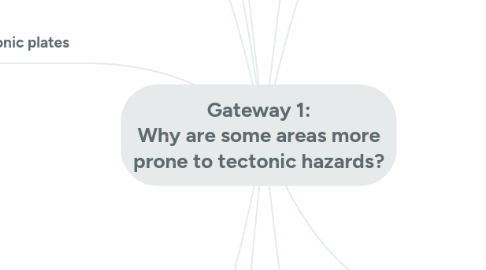
1. Natural Hazards
1.1. Climate-related
1.1.1. Caused by severe and extreme weather and climate conditions
1.1.1.1. Eg. Droughts, tropical cyclones, Floods
1.1.2. More widely distributed
1.2. Tectonic
1.2.1. Caused by plate movements 1) Convergent 2) Divergent 3) Transform
1.2.1.1. Eg. Earthquakes, volcanic eruptions, tsunamis
1.2.2. Mainly concentrated near the coastlines of the Pacific Ocean
2. Continental Theory
2.1. From Great Pangea to 7 continental plates
2.1.1. African Plate
2.1.2. Pacific Plate
2.1.3. Eurasian Plate
2.1.4. North American Plate
2.1.5. South American Plate
2.1.6. Antarctic Plate
2.1.7. Indo-Australian Plate
2.2. Evidence
2.2.1. -Fitting coastlines -Matching fossil reptiles in South America and Africa -Rocks of the same age and geological structure -Presence of coal under the Antarctic Ice caps
3. Plate Tectonic Theory
3.1. Earth crust divided into 7 major plates
3.2. Plates float on semi-molten mantle and are moved by convection currents
3.3. Edges of the plates are the zones of movement and are instable as well
3.4. 3 Main movements!
3.4.1. Transform
3.4.1.1. CONSERVATIVE
3.4.2. Convergent
3.4.2.1. DESTRUCTIVE
3.4.3. Divergent
3.4.3.1. CONSTRUCTIVE
4. How the Earth was built
4.1. God made Earth in 7 days
4.2. Big Bang Theory
5. Internal Structure of the Earth
5.1. CORE
5.1.1. Very dense
5.1.2. Central of the earth
5.1.3. Made of iron and nickle
5.1.4. Inner - 1200 km thick - Solid - High pressure
5.1.5. Outer - 2100 km thick - Semi-molten - 3000-5000 degree Celsius
5.2. MANTLE
5.2.1. Takes up 80% of the Earth's volume
5.2.2. 2900 km thick
5.2.3. Dense rocks
5.2.4. 800-3000 degree celsius
5.2.5. Lower - solid
5.2.6. Upper - solid rocks and athenosphere
5.3. CRUST
5.3.1. Less then 1% og the Earths volume
5.3.2. Few km to 70 km thick
5.3.3. Thinnest layer
5.3.4. Lighter Rocks
5.3.5. Consists of continental & oceanic plates
5.3.6. Crust + Upper Mantle = Lithosphere
6. Reason to why tectonic plates move
6.1. Convection currents
6.1.1. 1) Hot substances rises and cool substances sinks
6.1.2. 2) The material in the mantle is heated up by the core, thus expanding and rising , spreading out along the plates.
6.1.3. 3) The plates is then pulled away from each other
6.1.4. 4) The hot mantle slowly cools down and sinks, dragging the plates along as well.
7. 2 types of tectonic plates
7.1. Oceanic
7.1.1. Beneath deep ocean waters
7.1.2. 5 - 8 km thick
7.1.3. Mainly made of basalt
7.1.4. Less then 200 million years old
7.2. Continental
7.2.1. Land masses
7.2.2. 30 - 60 km thick
7.2.3. Made of lighter rocks
7.2.3.1. Eg. Granite
7.2.4. Wide range of rock ages
8. More about CONVERGENT plates
8.1. Continental - Continental (C-C)
8.1.1. Both lands are equally light
8.1.2. NO subduction occurs
8.1.3. Crust uplifted against each other
8.1.4. Land folds together and piles up
8.1.5. Fold mountains formed
8.1.5.1. Eg. Himalayas - India & Eurasian Plates
8.2. Continental - Oceanic (C-O)
8.2.1. Thinner, denser oceanic plate converges with the thicker, lighter continental plate
8.2.2. SUBDUCTION of the oceanic plate beneath the continental plate OCCURS, parts of the oceanic plate destroyed
8.2.3. Ocean trenches and fold mountains formed
8.2.4. Volcanoes made
8.2.4.1. Eg. Andes Mountains - Oceanic Nazca & Continental South America Plate
8.3. Oceanic - Oceanic (O-O)
8.3.1. 2 Oceanic plates collide
8.3.2. 1 plate will sink; most likely the denser one
8.3.3. Subduction occurs, parts of the crustal plate destroyed
8.3.4. Oceanic trenches, submarine volcanoes and volcanic islands arc/chains formed
8.3.4.1. Eg. Marianas Trench - Pacific Ocean
9. More about DIVERGENT plates
9.1. Result of rising magma within mantle just below the crustal plates
9.2. 2 C/O plates moving away from each other
9.2.1. (C - C) forms Rift Valleys
9.2.2. (O - O) forms Ocean Trenches
9.3. Mid-ocean ridges
9.4. forms new crust and new seafloor
9.5. Crust nearest to the ridge is the youngest
10. More about TRANSFORM plates
10.1. 2 Plates sliding/gliding past each other
10.1.1. Eg. 1) San Andreas fault - Pacific and North American Plates 2) North America Fault - Turkey and Anatolian Plate
